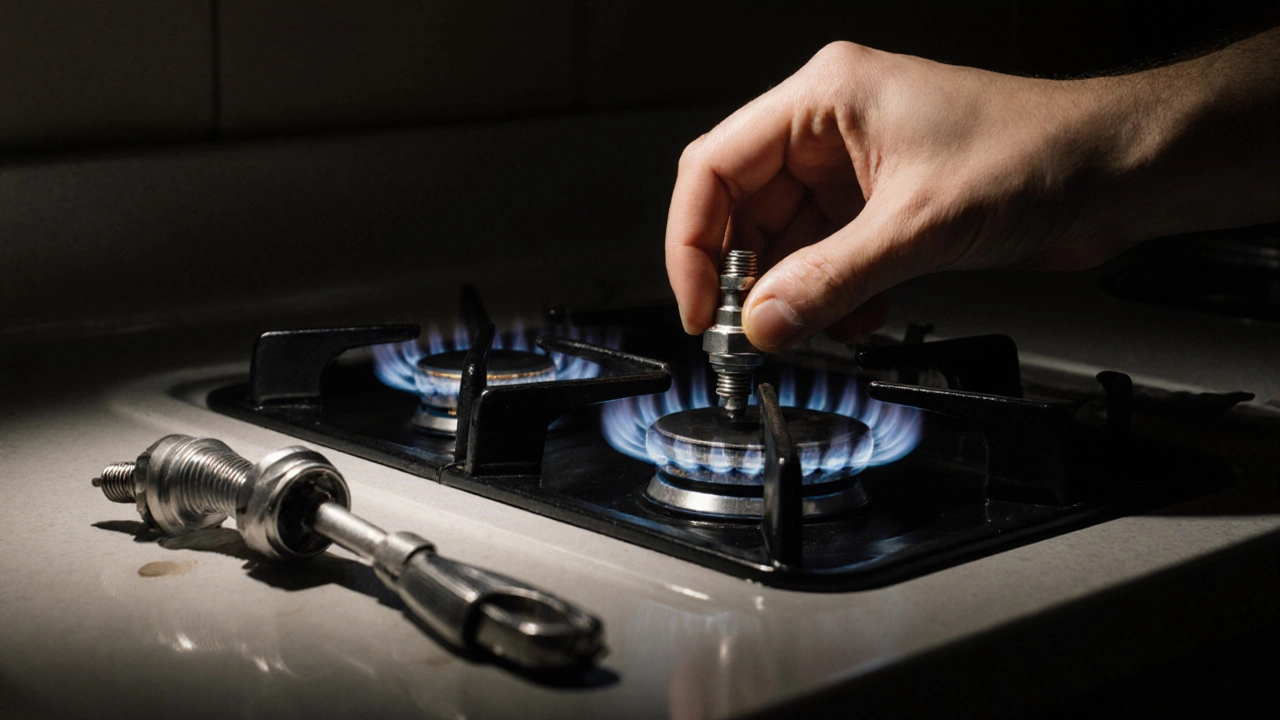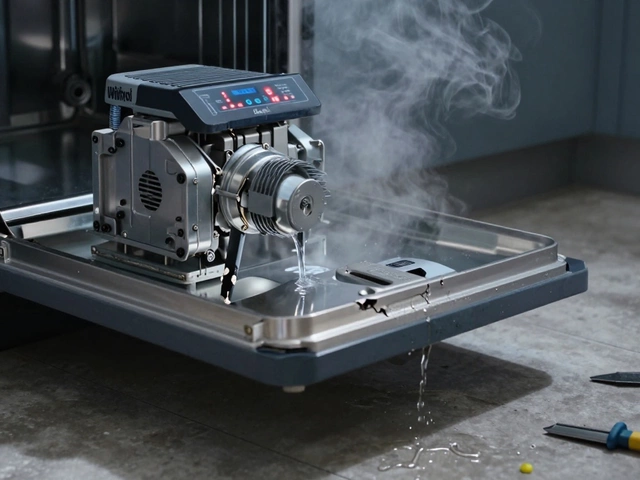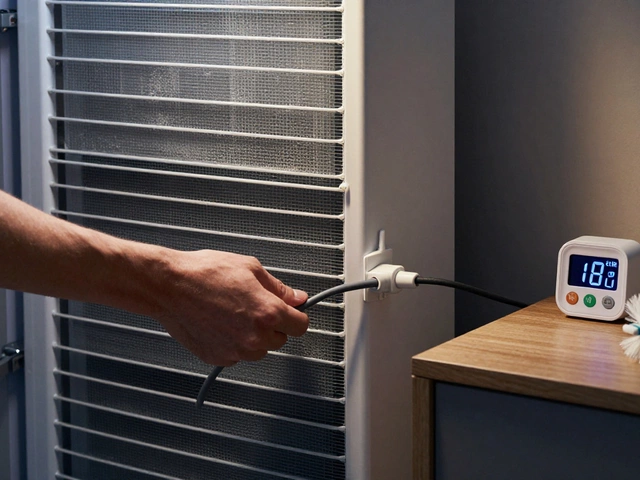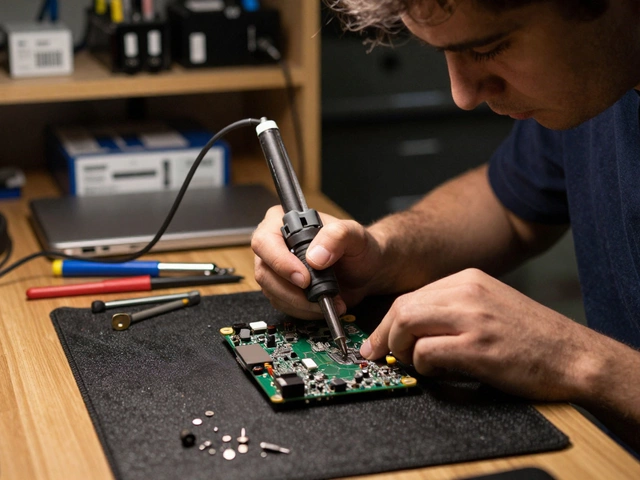If your gas hob suddenly stops sparking or the flames won’t light, you’re not alone. It’s one of the most common kitchen frustrations - especially when you’re trying to cook dinner and everything else in the house is working fine. Gas hobs are simple machines, but when they fail, it’s usually because of one of five predictable issues. Most of them don’t need a professional. You can fix them yourself in under 30 minutes with tools you already own.
Igniter Problems Are the Most Common Cause
The spark igniter is the little device under each burner that clicks when you turn the knob. If it stops clicking, the gas won’t light. But here’s the catch: it’s rarely the igniter itself that’s broken. More often, it’s gunk.
Food splatter, grease, and moisture build up over time around the igniter tip. That gunk acts like insulation. It stops the spark from jumping to the gas port. You’ll hear the clicking, but no flame. Clean it with a toothbrush and rubbing alcohol. Gently scrub the ceramic part and the metal electrode. Let it dry completely before turning the gas back on. I’ve seen dozens of hobs come back to life after this simple step.
If cleaning doesn’t help, the igniter might be worn out. They usually last 5-8 years. If your hob is older than that and the spark is weak or intermittent, replacing the igniter is cheap and easy. Most models use standard parts you can order online for under $20.
Blocked Gas Ports
Even if the igniter works, the flame might not light if the gas ports are clogged. Those tiny holes around the burner rim are designed to let gas out evenly. But over time, dried food, sugar, or even mineral deposits from hard water can plug them up.
Look closely at the burner head. If you see blackened or sticky spots around the holes, that’s your culprit. Use a needle or a pin - not a toothpick, it’s too soft - to gently clear each port. Don’t force it. You’re not trying to enlarge the hole, just remove the blockage. After cleaning, wipe the burner with a damp cloth and dry it well.
Some people try to clean burners in the dishwasher. Don’t. The high heat and harsh detergents warp the metal and clog the ports even more. Hand-wash with warm soapy water instead.
Faulty Gas Valve or Control Knob
If one burner works but another doesn’t, the problem is likely isolated to that burner’s gas valve. The valve controls how much gas flows to the burner. If the internal seal wears out or gets sticky, gas won’t flow even when the knob is turned.
To test this, swap the control knobs between a working burner and a non-working one. If the problem moves with the knob, you’ve found the issue. Replacement knobs are usually under $15. If the problem stays with the same burner after swapping knobs, the valve inside the stove is faulty. That’s when you call a technician - unless you’re comfortable disassembling the hob. Most DIYers avoid this because it involves removing the cooktop and accessing the gas line.

Thermocouple Failure
Older gas hobs have a safety feature called a thermocouple. It’s a small metal rod next to the burner that senses heat. If the flame goes out, the thermocouple cools down and shuts off the gas to prevent a leak. But if the thermocouple is dirty, bent, or worn out, it can think the flame isn’t lit - even when it is.
Look for a thin copper-colored rod sticking up near the burner. Clean it with fine steel wool. If it’s bent, gently straighten it so it’s about 1/4 inch from the flame. If cleaning doesn’t help, replace it. Thermocouples cost less than $10 and are easy to swap. Just disconnect the wire, unscrew the old one, and screw in the new one. Tighten it snugly - don’t over-torque.
Gas Supply Issues
Before you start tearing into the hob, check the basics. Is the gas shut-off valve behind the stove turned on? It’s easy to accidentally knock it closed when cleaning or moving the appliance. Turn it fully counterclockwise to open it.
Also, check if other gas appliances in your home are working. If your oven or water heater is also out, the issue is likely the main gas line or meter. Call your gas provider immediately. Don’t try to fix this yourself. Gas leaks are dangerous.
In colder climates like Vancouver, condensation in the gas line can sometimes freeze in winter. If you’ve had a sudden cold snap and the hob stopped working, give it a few hours to thaw. Don’t use heat guns or blow dryers - that’s a fire hazard.

What to Do If Nothing Works
If you’ve cleaned the igniter, cleared the ports, checked the gas valve, replaced the thermocouple, and confirmed the gas supply is on - and it still doesn’t work - the problem might be deeper. It could be a faulty control board, damaged wiring, or a cracked gas manifold. These are rare, but they happen.
At this point, it’s time to call a licensed appliance repair technician. Don’t keep guessing. Gas appliances aren’t toys. A professional can test gas pressure, check for leaks with a manometer, and inspect internal components safely.
As a rule of thumb: if your hob is over 12 years old and you’re spending more than $150 on repairs, it’s usually cheaper and safer to replace it. New models are more efficient, have better safety features, and come with a 1-2 year warranty.
Prevention Tips to Avoid Future Problems
Keep your gas hob clean. Wipe spills right away. Don’t let sugary sauces or oily splatters bake onto the burners. Once a month, remove the burner caps and grates and soak them in warm soapy water. Dry them completely before putting them back.
Don’t use abrasive cleaners or steel wool on the igniter. It’s ceramic and can crack. Use a soft brush and isopropyl alcohol instead.
Replace the igniter and thermocouple every 5-7 years as preventive maintenance. It costs less than $30 total and prevents sudden failures during busy cooking times.
And always make sure the area behind your hob is clear. Keep it free of cardboard, paper, or cleaning supplies. Heat and gas need airflow.
Why does my gas hob click but not light?
If your gas hob clicks but doesn’t light, the spark is working but the gas isn’t reaching the flame. The most common reason is a clogged gas port or a dirty igniter. Clean the burner holes with a needle and wipe the igniter with rubbing alcohol. If that doesn’t work, check if the gas valve is open and the thermocouple is properly positioned.
Can I use WD-40 to fix a gas hob?
No. WD-40 is flammable and leaves a residue that can clog gas ports or damage seals. Never use it on any part of a gas appliance. Use isopropyl alcohol for cleaning and food-grade silicone grease only for moving parts like knobs.
Is it safe to light a gas hob with a match if the igniter fails?
Yes, but only if your hob is designed for it. Most modern gas hobs have safety valves that won’t release gas unless the igniter is active. If you’re unsure, check your manual. If your model allows manual lighting, hold a long match or lighter near the burner, then turn the knob to low. Never leave the gas on without lighting it - you risk a gas buildup.
How long do gas hob igniters last?
Most igniters last between 5 and 8 years, depending on how often you use the hob. If you cook daily, expect to replace them closer to the 5-year mark. Signs of wear include weak sparks, clicking without ignition, or intermittent operation. Replacing them early prevents bigger issues.
Should I replace my gas hob if it’s over 10 years old?
If it’s working fine, no need to replace it just because of age. But if you’re facing repeated repairs - especially multiple parts failing in a short time - it’s usually more cost-effective to upgrade. New models are 20-30% more energy-efficient, have better flame control, and include safety shutoffs. Plus, replacement parts for older models are harder to find.





